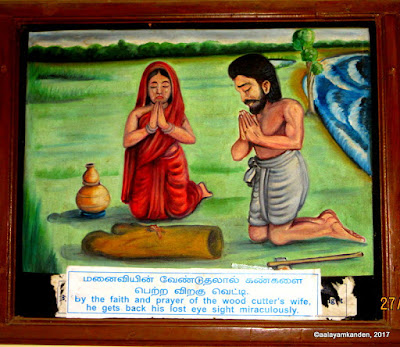 |
| Kathithamalai Vetri Velayudha Swamy Temple |
Mythology:
Once Sage Agasthya was visiting all Muruga temples in the Kongu region. He was accompanied by Sage Narada and the Devas. When they came to this place, Sage Agasthya was extremely thirsty. There was no water to be found anywhere nearby. So, he prayed to Lord Muruga who appeared before him, and hit the ground with his spear (Vel). Immediately, water came gushing out from the pit formed when Muruga's spear hit the ground. Since it was an ootru (spring) which came forth from a Kuzhi (pit), the place came to be known as Utrukuzhi which slowly morphed into Uthukuli.
Sage Agasthya was very grateful to Lord Muruga for having appeared before him to quench his thirst. So he installed him in the same place in the form of a swayambu. This swayambu which looks like a small mound or lingam is in the sanctum sanctorum right next to the idol of Lord Muruga.
Temple:
The temple is found on a small hillock. There are steps to climb and vehicles also ply right upto the entrance of the temple. There is a beautiful five-tier Rajagopuram at the entrance and the temple is spotlessly clean and freshly painted. As we enter, we are welcomed by screeching peacocks which move from one mandapa to the other, unmindful of the crowd beneath.
In the sanctum sanctorum, Lord Muruga is unusually found alone, without Valli and Devayanai, who are found together in a seperate shrine behind the temple. The legend again explains that both of them were desirous of marrying Lord Muruga and came here to worship him and since this was a pre-marriage shrine, they are found together behind the temple, but away from Lord Muruga. Therefore in this temple, Lord Muruga is found as an embodiment of Gnana, without Valli and Devayanai who are the Ichcha Sakthi and Kriya Sakthi.
Because of this, on every Tuesday, special abhishekams are performed to Lord Muruga at 5 am. Then from 6 am to 7 am, a special prayer comprising of 300 verses called Shatru Samhara Thrisathi is performed. Those desirous of obtaining success in their career, marriage, or education, or those who want to get rid of enemies, evil forces or competition, come here to perform the Thrisathi and find success in their lives. It is because of this that he is called Vetri Velayudha Swamy. The sthalavriksham of this temple is Vilvam.
Near the Valli Devayanai shrine, there is a frontier deity called Sukkumalaiyaan who is worshipped by devotees, by tying cradles on the Paalai tree (Blackboard Tree, also known as Saptparni), under which he sits.
Beneath the temple on the South, there is a samadhi of a saint Mayuranatha Siddhar which is popularly known as Subbarayar Kovil. There is a huge anthill inside this temple and it is believed that the anthill has developed over the samadhi of the siddhar. Till some time ago, the samadhi was open to public for worship. Currently there are three snakes that live within the anthill. They appear before the devotees periodically, but do not harm anyone.
Few months ago, someone set the anthill on fire accidently while lighting camphor, post which, the anthill is cordoned off. Devotees are also prohibited from pouring milk and eggs on the anthill. There is a seperate enclosure for making offerings, and for sacrificing hens.
Those suffering from Rahu, Kethu Dosham, come to the Subbarayar temple and worship him by offering milk and eggs to the snakes in the anthill.
While it is believed Arunagirinathar visited Kathithamalai and sang about Vetri Velayudhaswamy, no direct Thirupugazhs are attributable to this temple, at the moment.
While all festivals associated with Murugan are celebrated here with a lot of splendour, the most famous is the Thai Poosam. On the fourth day after Thai Poosam, devotees pull the decorated temple car around the hill. This is probably the only temple where the wooden car is pulled around a hill.
This temple features amongst the six Kongunattu Arupadai Veedu for Lord Muruga. It is considered to be a very powerful place for worship and hundreds of devotees throng here every day.
How to get here: Kaithamalai is 15 kilometers from Tirupur city on the Tirupur - Erode Road.
Temple Timings: 5.30 - 2 pm, 4-8 pm
Contact Details : 04294-262052
























































